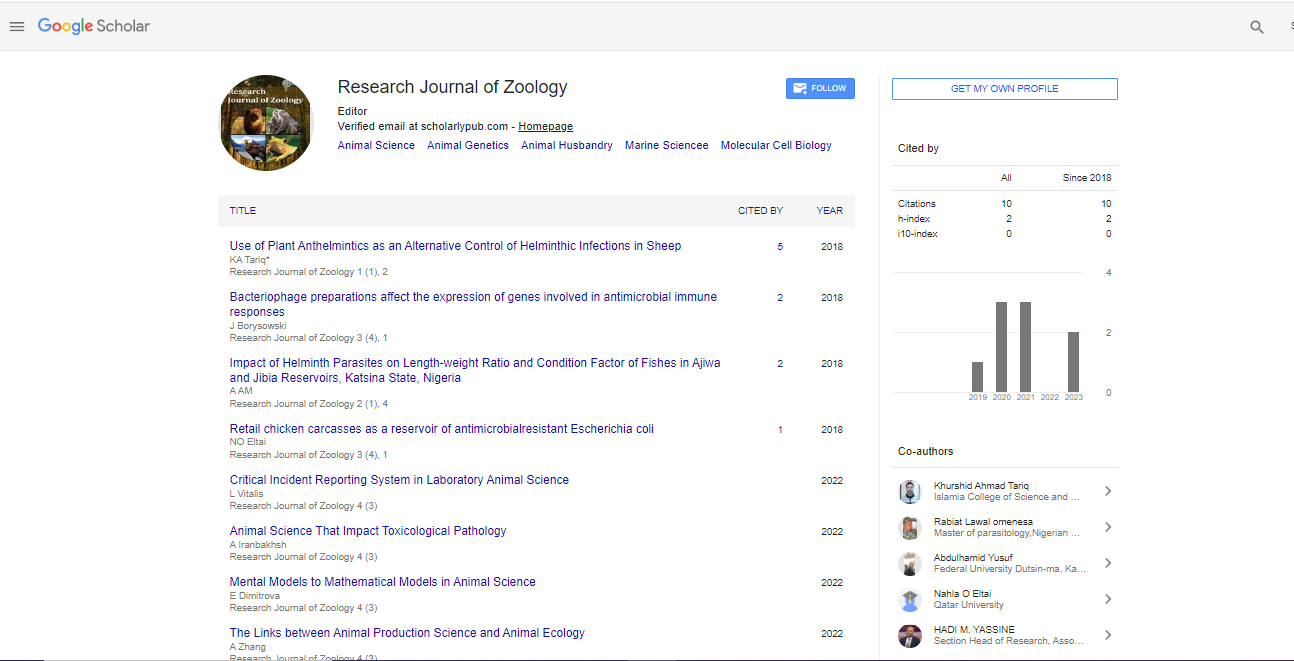Commentary, Res J Zool Vol: 5 Issue: 4
Developmental Biology: Regeneration, Repair and Tissue Formation
Leon Estebane*
1Department of Biology, National University of La Plata, La Plata, Argentina
*Corresponding Author: Leon Estebane,
Department of Biology, National
University of La Plata, La Plata, Argentina
E-mail: estebane.leo@gmail.com
Received date: 21 November, 2023, Manuscript No. RJZ-24-128411;
Editor assigned date: 23 November, 2023, PreQC No. RJZ-24-128411 (PQ);
Reviewed date: 07 December, 2023, QC No. RJZ-24-128411;
Revised date: 15 December, 2023, Manuscript No. RJZ-24-128411 (R);
Published date: 22 December, 2023, DOI: 10.4172/RJZ.1000099.
Citation: Estebane L (2023) Developmental Biology: Regeneration, Repair and Tissue Formation. Res J Zool 5:4.
Description
Developmental biology, a captivating study in the field of biology, explores the complexities of life's continuing direction from the fusion of a sperm and egg to the complex symphony of tissues and organs that constitute a fully-formed organism. The developmental biology is located the exploration of embryonic development and the transformation of a single fertilized egg into a multicellular organism with specialized cells and tissues. This difficult process, frequently described as ontogeny, recapitulates the evolutionary history of organisms establishes the foundation for the astonishing diversity observed in the natural world.
Fertilization marks the commencement of this remarkable study. The union of sperm and egg results in the formation of a zygote, a single-cell embryo with the complete set of genetic instructions required to provide development to a complicated organism. The zygote divides into a sequence of cells to produce a blastula, which is a hollow ball of cells. Gastrulation follows, as cells within the blastula require a coordinated movement to create distinct germ layers, endoderm, mesoderm, and ectoderm. These layers serve as the precursors for different tissues and organs, setting the stage for the subsequent development of complex body structures.
Morphogenesis, the shaping of tissues and organs, develops as an array of complicated cellular motions, differentiations, and association. The process is finely tuned by molecular signals, with genes coordinating the development of specific structures and ensuring spatial and temporal precision.
Hox genes is a group of master regulatory genes, play an essential role in establishing the body plan of organisms. They control the identity of body segments and guide the development of structures along the anterior-posterior axis. The evolutionary conservation of hox genes highlights their fundamental role in shaping the diversity of life.
Cell differentiation and tissue formation
As development progresses, cells become increasingly specialized through a process known as cell differentiation. This specialization generates different cell kinds with specific functions, contributing to the formation of tissues and organs.
Stem cells, versatile cells with the capacity to develop into various cell types, are important players in the process of cell differentiation. Embryonic stem cells, derived from the inner cell mass of the blastocyst, possess pluripotency, the ability to differentiate into any cell type in the body. Adult stem cells, found in various tissues, contribute to tissue maintenance and repair.
Organogenesis, the formation of organs, is a complex movement of cell movements, differentiations, and tissue interactions. Each organ follows a specific developmental program guided by specific sets of genes. For example, the cardiac develops complex connecting and septation processes guided by genes such as NKX2.5 and GATA4.
An enchantment of complicated nervous system develops through neurogenesis and the migration of neurons to their designated locations. Axon guidance, regulated by molecules such as netrins and semaphorins, ensures the precise wiring of neural circuits, laying the foundation for sensory perception, motor control, and cognition.
Regeneration and repair
Developmental biology also provides illumination on the regenerative capacities of organisms. While some organisms exhibit remarkable regenerative abilities such as the axolotl's ability to regrow entire limbs others, such as humans, possess more limited regenerative potential. Understanding the cellular and molecular mechanisms behind regeneration provides the possibility of advancements in regenerative medicine and tissue engineering.
Stem cells, with their specific ability to differentiate into various cell types, are central to the regenerative processes observed in some organisms. The study of these regenerative mechanisms provides insights into the potential for enhancing tissue repair and regeneration in humans.
 Spanish
Spanish  Chinese
Chinese  Russian
Russian  German
German  French
French  Japanese
Japanese  Portuguese
Portuguese  Hindi
Hindi 
